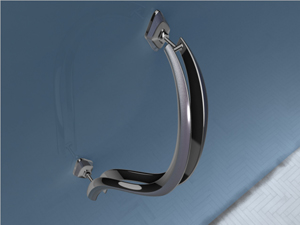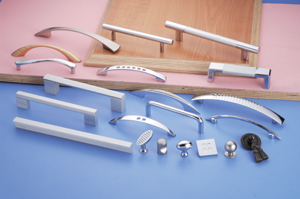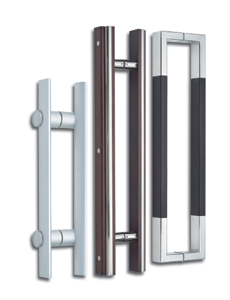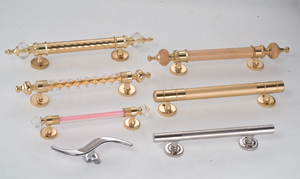Taiwanese Furniture Hardware Makers Undaunted by Slowdown
2010/06/09 | By Steve ChuangA typical, slightly disheartening tale surrounds Taiwan's central counties of Taichung and Changhua, where many of the furniture hardware makers saw prosperous times for a while after the island's export-dependent economy took off in the 1960s. But changing times as rising competition from emerging economies, higher labor cost in Taiwan cast shadow over the golden era in the 1990s, when most furniture and parts makers migrated to China and Southeast Asia to tap lower costs.
Industry insiders who remain in Taiwan says the number of furniture hardware makers still operating on the island has decreased to less than 20 from the pre-1990s peak of 40-50. The disappointing tale worsened after the global meltdown in early 2008, which pushed smaller operators over the edge, forcing a few to shut down production lines for a while.
Optimists say that some Taiwanese furniture hardware makers look forward to a continuing recovery in 2010, which seems to be happening in China and other emerging markets as Latin America. Three such furniture hardware makers talk to CENS about the ups and downs of business, as well as coping plans.
Production Upgrades
Chang Mei Co., Ltd., established in 1984 in Changhua County, central Taiwan, has been specializing in production and development of furniture hardware as cabinet knobs, and its strong commitment to production upgrades has helped to build trustworthiness among customers for over twenty years.
With around 50 employees and a 1300-square-meter factory, Chang Mei is a modestly-scaled operator but renowned as one of the most experienced OEMs in the line, turning out a variety of cabinet knobs, pulls, legs, towel hooks and accessories, over 90% of which is exported to the U.S., Europe, Japan, Australia and Latin America.
Not taking all the credit for a key innovation that has allowed his firm to make a significant leap over counterparts, the president L.C. Yang says his firm is especially noted for its application of composite materials, a technology developed many years ago with critical help from academic institutions. Also obviously green-sensitive, Chang Mei painstakingly makes sure eco-friendly, lead-free electroplating solutions are used.
And as savvy as one operator in the southern USA, who was reported on TV recently to claim that a factory can be set up stateside as cost-effectively as in China if efficiencies are maximized, Yang says that his company adopted the same solutions in the early 1990s to avoid moving offshore to China or Southeast Asia. Specifically Yang since the 1990s has focused on sharpening production capability and integrating production lines in-house to offset cost advantages that can be derived by relocating. “Having integrated production facilities in-house can better assure consistent quality, stable quality, upgraded customer service and on-time delivery than rivals,” he says.
Further justifying his corporate philosophy, Yang says trying to upgrade capability not only builds reputation and trust among customers, but also makes sense, for buyers simply want to do business with reliable, capable suppliers.
Integrated Production
A relatively younger counterpart than Chang Mei that also boasts integrated production lines in-house is Chiao Feng Hardware Industrial Co., Ltd., which reputedly focuses on molding R&D and was founded in 2003.
The firm's seven-year history does not do the company justice; because often such entrepreneurs have been working in the line for many years before going into business, hence accumulating considerable technical expertise. The firm in fact has over 20 years of experience in metalworking, which enables the maker to work with wide-ranging metals as zinc, aluminum, steel, iron, stainless steel and specialty alloys to turn out various furniture hardware, knobs and fittings.

Go with the Flow
Giving Japanese customers what they want clearly has paid off: the company exports 90% of its products a year, up to 70% of which goes to the Japanese market. Another side benefit of integrating production lines in-house is being able to achieve flexibility in production and improve quality control, says Yang. He offers a piece of very practical wisdom: “Since large orders in the traditional industry of furniture hardware manufacturing is rare, we must figure out ways to raise quality while improving efficiency to stay competitive.”
Not one to hype apparently, Tsai confesses that his company did not evade the global crash, having suffered deep sales decline in 2009, especially in the first half. But undaunted by hardship, the company, in addition to streamlining organization for optimal operation efficiency, has been investing in R&D even during the downturn, trying to improve on structural designs and developing new molds. “Unlike conventional molds that turn out single-length handles, the new molds enable higher versatility: producing length-adjustable handles for furniture.” Tsai says. “Thankfully, we have seen a turnaround since the molds were installed in the second half of last year…and we're poised to explore the Russian market this year.”

A living example of one who has been successful in product differentiation, Chih Hsiang Hardware Co., Ltd., has shown that “bigger may be actually better.” This maker has been turning out larger door handles to differ from those made by others in Taiwan. Established in 1993 in Taiwan's central city of Changhua, Chih Hsiang Hardware Co., Ltd. has effectively carved out a niche with such savvy strategy.

Leader in Taiwan
Such dedication has paid off: not only has the maker evolved into a leading supplier of its kind in Taiwan but it also commands a 90% market share on the island, in addition to building solid footholds in the Middle East, South Asia and Japan. Besides, the company is also a well-known OEM and ODM.
Literally the textbook example of the perfect corporate executive, Chen, despite the success achieved so far, continues to upgrade production capability, enrich material science know-how such as working with metals and composites, coating technologies as PVD (physical vapor deposition), aiming to hold its lead in Taiwan. Clearly very capable, the company can make the longest door handles in Taiwan, up to 3.3 meters.
Proving that investing in R&D makes sense, the firm achieved sales growth in 2009, sharply contrasting most of its peers who suffered sales declines to some degree. Chen attributes such success also to plain hard work to fill custom orders. “Above all, our decade-long dedication to exploring the niche market has worked,” says Chen, who humbly neglects to mention that the firm's success is truly notable considering the playing field has been unfairly tilted towards Chinese and southeast Asian rivals.
Despite the global slowdown in construction worldwide, especially in the Middle East after the recent Dubai Crisis, Tsai expresses optimism towards the market outlook this year, also hinting at its plans: “We have kicked off R&D that will enable us to turn out larger handles…and we will focus on cooperating with builders and distributors.”





